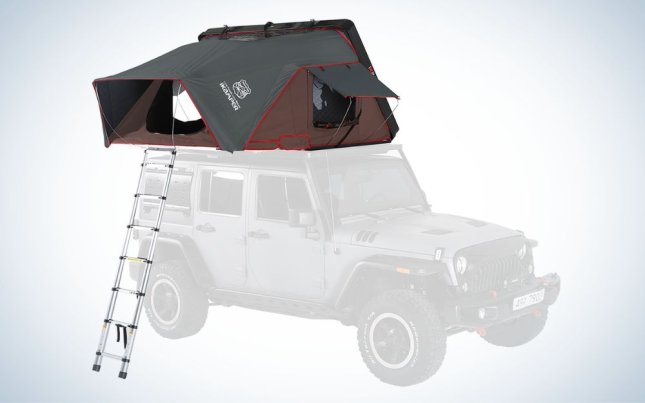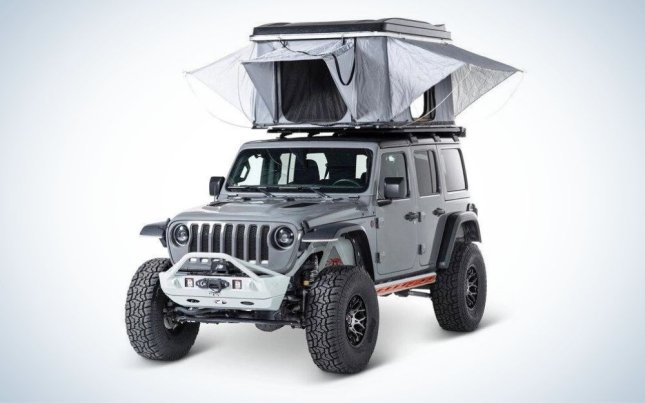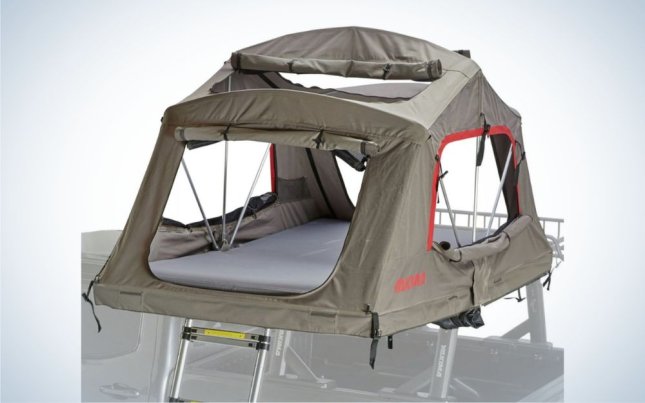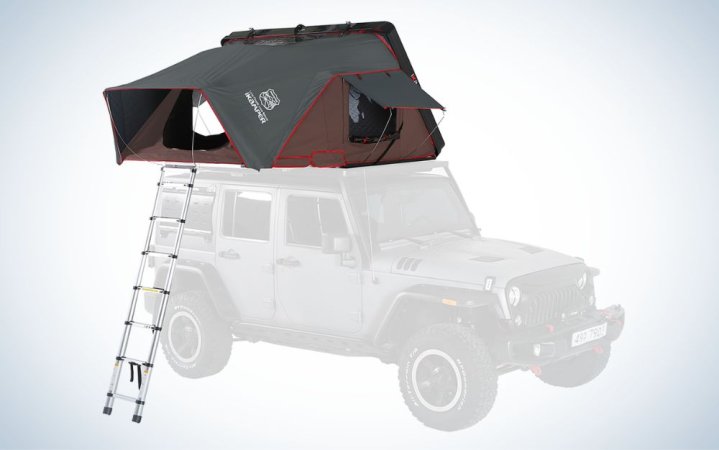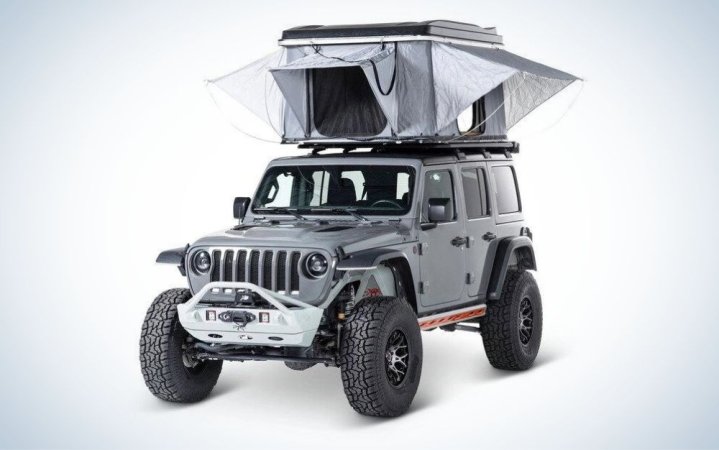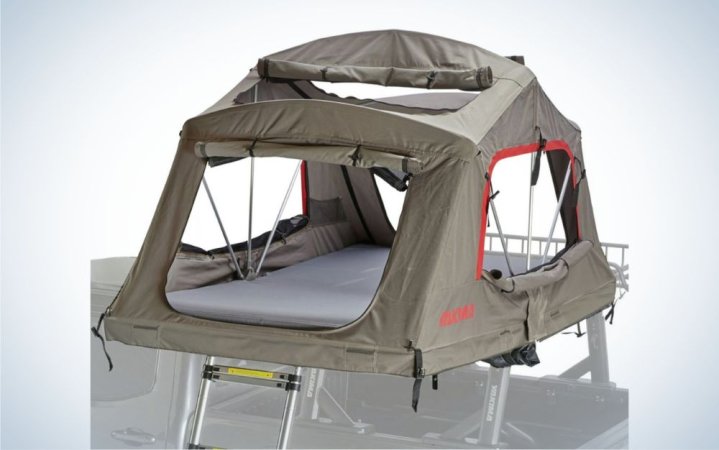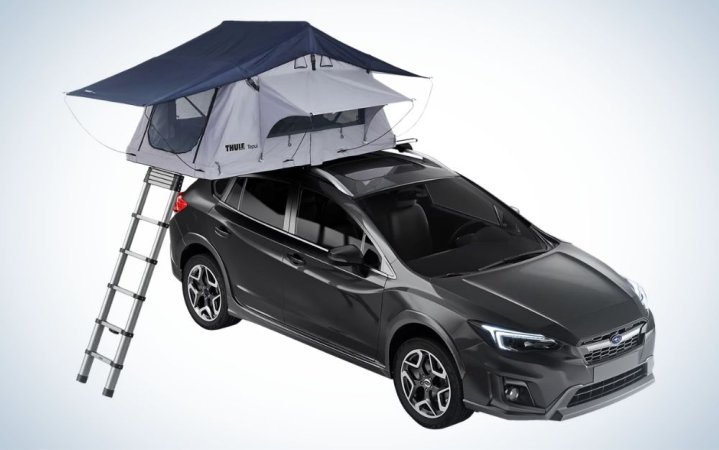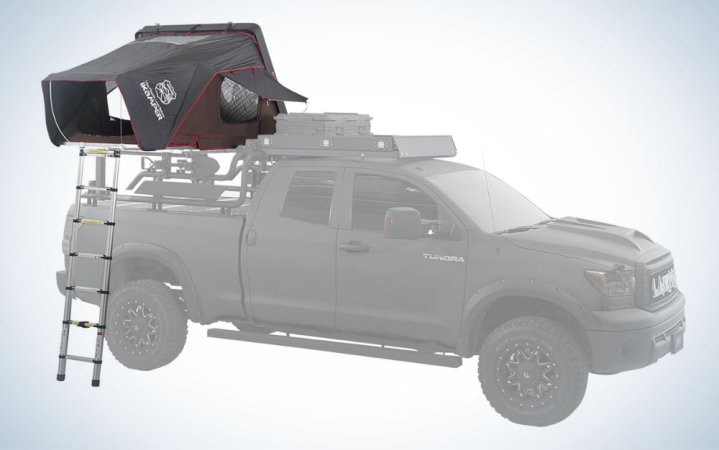We may earn revenue from the products available on this page and participate in affiliate programs. Learn More ›
Finding new ways to get outside is creating record sales for everything from tents to RVs, and it’s creating a rise in other alternatives, like roof top tents.
As the name suggests, roof top tents attach to roof racks on your car, truck, or overland vehicles. The options include a long list of variables in design, price, and size, so finding the best roof top tent for you can take a little bit of work, but fortunately, there is a tent for just about anyone with any vehicle.
There are a lot of advantages to roof top tents compared to traditional tents, and as long as you can park your car at the campground, you should be good to go. Roof top campers enjoy a comfier setup getting them off the ground and a more weatherproof design. Plus, almost all roof top tents have an amazingly quick setup and breakdown time, allowing campers more time to enjoy their destination.
Here’s a look at what roof top tents offer and what is the best roof top tent for you.
- Best Overall: iKamper Skycamp 2.0
- Best Hardshell: Smittybilt Overlander Hard Shell
- Best Softshell: Yakima Skyrise HD Medium
- Best Budget: Thule Tepui Explorer Ayer
- Best for Small Cars: iKamper Skycamp Mini
How to Choose the Best Roof Top Tent

Similar to any piece of outdoor gear, there are a lot of factors to finding the best roof top tent for you.
For roof top tents, the first item to account for is what kind of vehicle you have and what it can carry. Tents come in various weights and setups. Not every tent can go on every car, and some are designed specifically for smaller vehicles that hold less weight. This is also related to the crossbars on your vehicle, as a basic crossbar setup may not be enough to hold every tent, even if your car or truck can handle the weight.
Before making any considerations, you should consult your vehicle’s owner’s manual to find out the dynamic load and static weight it can handle. The dynamic amount is the weight a car can handle when it is in motion. It’s usually hundreds of pounds less than the static weight, which is when the vehicle is standing still. The total weight of the tent needs to be less than the threshold for your vehicle’s dynamic weight or else you could risk damaging your vehicle or others while driving down the road. To calculate the static weight, add the tent plus the number of people and items you plan on having inside on any given night.
Another big consideration is how many people plan on sleeping in that tent? Upgrading to a roof top tent should bring more comfort to the campers, so too small of a setup with too many people and pets inside may have the opposite effect. While some tents barely allow for two, others can fit a family of four, with some companies adding additional accessories to build out your camp even more with extra room. If you’re looking to expand your indoor space, I suggest researching the best canopy tents to add to your camp.
Best Overall: iKamper Skycamp 2.0
Best Overall
Pros
- Universal mounting system allows it to fit on most vehicles
- King size memory polyfoam mattress
- Easy one minute set-up time
- Multiple layers allow for easy window access during the day and a dark and secure tent at night.
- Four season tent
Cons
- Heavier than other tents and therefore not for all vehicles
Key Features
- Hardshell case
- Sells for around $3,700
- Weighs 160 lbs.
- Can sleep up to four people
Why It Made the Cut
iKamper’s Skycamp 2.0 is one of the most popular tents on the market, and for a good reason. Even if you don’t know much about roof top tents, once you see the iKamper name, you’re bound to notice it on plenty of SUVs and trucks. The tent sets up quickly and is roomy enough to fit several people and pets.
Product Description
The iKamper Skycamp 2.0 roof top tent is a great introduction to roof top camping while also being a longtime mainstay on the market. The sleek design, spacious tent, and tough shell make the Skycamp a very popular option.
I drive a Subaru Forester, which pushes the weight limit to the threshold, but it’s still below the maximum, making my vehicle not the best choice for this tent, but still doable. Installation of the tent is effortless as long as you have help lifting the 160-pound tent onto your roof rack. From there you just tighten four screws and your tent is secure.
When driving with the tent, you’ll notice some shifting from the wind and the added weight on your roof. It’s also recommended you watch your speed while driving. But, once I got used to it, I hardly noticed it on my car.

Once arriving at the campsite, the Skycamp 2.0 lived up to the hype of an easy setup. Once you open the box, the tent pops open, and you’re left only with propping up the doorway and windows. Getting in and out of the tent is easy with the included ladder, which also acts as a stand to keep the tent up. Multiple windows and a skylight also allow plenty of light and airflow throughout the tent.
I spent multiple nights in the tent, both solo and with my wife and toddler. Solo, you have more than enough room for just about anything, but even with two added people, the tent still felt massive inside. Inside the bed, there is a polyfoam king-size mattress taking up the entire floor space as well as some storage pockets along the perimeter. The mattress is extremely comfortable and beats most standard tent setups.
I experienced a good mix of weather by camping in two different regions of Colorado and can say this is a four-season tent. The multiple layer windows allow you to close it with canvas covers, let light in through the plastic screen or leave just the mesh up for easy airflow for warmer weather. With everything closed, we were able to stay warm even with minimal layers and blankets in the canvas tent.
The biggest struggle with the roof top tent is windy weather. At one point, strong winds blew in it, and it was a struggle to get the tent closed. A few minutes of chaos were underway, but once I had the box shut, we were able to move to wait out the storm until things calmed down.

However, inside the tent, you could also feel the strong gusts overnight. I don’t believe the tent was going anywhere, and it was firmly strapped to the roof. Part of this issue may have been my smaller SUV compared to a heavier truck or jeep that could secure the tent more in place and avoid rocking from the strong winds.
iKamper recently released their Skycamp 3.0, a slightly pricier upgraded version of the longstanding popular 2.0. With it comes some improvements like a better mattress and a large hardshell box to allow for some storage such as blankets or a pillow.
Overall, the Skycamp is hard to beat, with a great setup that’s easy enough to use just about anywhere. While not nearly as large as some of these family tents, I can see the Skycamper as the best roof top tent for families or just adventure friends looking for a comfortable space option, as the Skycamp hits all the marks. It also is probably the best for cold weather options with its generous interior allowing for extra blankets while also using its thick canvas as protection.
Best Hardshell: Smittybilt Overlander Hard Shell
Best Hardshell
Pros
- Lightweight for a hard shell roof top tent
- Packs tight, allowing for an aerodynamic design
Cons
- At just over three feet tall, this tent’s roof is fairly low when set up
Key Features
- Sleeps three people
- Rugged design for overlanders
- Weight: 120 pounds
Why It Made the Cut
This sleek tent packs down tight while weighing and costing less than some of the competition.
Product Description
Smittybilt is an overland company, meaning they keep their audience in mind with their designs. For the Overlander Hard Shell tent, the sleek design makes it a great option for many users looking to keep a low profile while also spending a little less on a hardshell tent compared to other brands. Aesthetically, this tent is also simpler, as it pops straight up, keeping the size of the box it travels in.
Best Softshell: Yakima Skyrise HD Medium
Best Softshell
Pros
- Comes with a weatherproof rainfly
- Designed for four-season
- Lightweight
Cons
- Some users say setup time takes longer compared to iKamper and other products
Key Features
- Holds up to three people
- Weight: 115 pounds
- Softshell case
Why It Made the Cut
This Yakima roof top tent is popular for a long list of reasons, including its price and lightweight. Softshell tents, in general, are lighter for the obvious reason of less heavy material, and the Skyrise is one of the market leaders.
Product Description
The majority of roof top tents are softshells, which offer less protection for travelers than hard shells, but save on weight and in most cases, costs. The Yakima Skyrise is a popular option that requires a little bit more work to set up compared to some roof top tents that essentially spring up, however, it’s still a quick option compared to traditional tents.
Best Budget: Thule Tepui Explorer Ayer
Best Budget
Pros
- Very affordable
- Lightweight, so it works for most vehicles
- Good entry into roof top tents
Cons
- Only fits two people with a maximum weight of 400 lbs.
- Set up time can be about ten minutes.
Key Features
- Sleeps two people
- Weight: 100 pounds
- Softshell design
Why It Made the Cut
If you’ve seen a roof top tent around town or in the woods, there’s a good chance it was a Thule Tepui. The tent may be the most popular on the market for not only the price but the quality that comes with it.
Product Description
The Thule Tepui Explorer Ayer is a great tent for those new to roof top tenting. The low price helps make this a very popular option. Something to consider with the Tupai is the maximum weight of 200 pounds and the fact that cheaper can also mean lower quality in some instances, such as multiple reviews complaining about the mattress.
Best for Small Cars: iKamper Skycamp Mini
Best for Small Cars
Pros
- Small enough to fit on just about any vehicle
- Hardshell case protects the tent
- Same design as the Skycamp 2.0 and should work great for all season
Cons
- Smaller means less room and it’s a little snug
- Priced higher than some similarly sized tents
Key Features
- Hardshell case
- Sleeps two people
- Weight: 125 pounds
Why It Made the Cut
The Skycamp Mini has the same design as the Skycamp 2.0 but weighs less and can fit on just about any vehicle, making this a great option for those who are limited by what they drive.
Product Description
iKamper wanted to make sure just about anyone could get a roof top tent, and that led to the Skycamp Mini. Modeled after the popular Skycamp 2.0, the Mini weighs 35 pounds less and, at 125 pounds, comes in well below the 150-pound mark a lot of vehicles max out at when it comes to roof top weight. To showcase this, the company advertises the Mini on top of a MINI Cooper to get their point across. However, this is also a popular option for truck beds as well.
With less weight, comes less room, as this tent is designed to hold only two people. Similar to the 2.0, iKamper released the Skycamp Mini 3.0 for pre-order. The 3.0 is an updated version of the Mini to fuel the demands of a growing audience.
Methodology

The best way to test a roof top tent is simply to get out there and test it.
With the Skycamper 2.0, I initially opened it up at home to get an idea of how it worked and how to put it away to avoid being stranded anywhere in the Colorado mountains.
- Setup and Breakdown: The more you use these tents, the easier setup and breakdown becomes. I was able to open and close these tents on different terrains including northern Colorado and the Gunnison National Forest area.
- Camping: To further test it, I spent time alone in the tent and also with my family to get a feel of what it was like to have multiple people inside.
- Weather: Luckily, I didn’t experience any severe weather, however, there was a night of strong winds that revealed how these tents handle being up in the air with 30 mph gusts.
- Research: As I stated about weight and understanding your vehicle, it’s important to do some research first into each tent to understand how they work and if they can be safely used with your car or truck. I spent time reading reviews and understanding specs to ensure I was covering the top tents for each section of this review.
FAQs
Definitely not. It’s important to pick a tent that can fit safely on your car. Anything overweight risks not only your vehicle but yourself and other drivers. Finding the right design and weight is essential.
Unfortunately, yes. An article from Consumer Reports goes more in-depth, but even simple roof racks can impact your gas mileage. Adding an entire box weighing about 150 pounds is sure to only decrease your gas mileage.
Yes. Installing a roof top tent is easy in most cases, but almost all require roof racks to properly secure it to your car or truck.
It’s best to stay under 70 mph when driving with a roof top tent. The dynamic weight is impacted by high speeds, putting additional stress on your vehicle and braking system. To safely get to your camping destination, you should know it may take a little longer than usual.
Similar to your vehicle’s dynamic weight, it’s important to check the maximum weight your roof racks can support. Roof top tents are not cheap, and it can be worth investing in quality racks to protect your tent.
Final Thoughts
Roof top tents are a great alternative to camping, bringing added comfort and an easy setup to anyone who loves the outdoors. Those looking to get the best roof top tent should research their vehicle’s capabilities while comparing different tent brands. Safety is a big factor in roof top tents, and you need to be sure your car or truck, and roof racks are properly set up for your tent.

